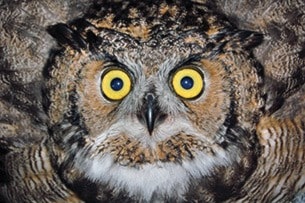It’s a record-breaking year for BC SPCA Wild ARC, with nearly 30 per cent more patients arriving during the summer months than last year.
And fall brings its own share of distressed patients, and typically many injured raptors – particularly owls – needing a helping hand.
As the days get shorter, drivers are heading to and from work in the dark.
Nocturnal animals like owls are also active at these times, often hunting near roadsides for small rodents like mice and shrews that make up the majority of their diet.
As a result, they are at higher risk from vehicle collisions at this time of the season, and Wild ARC sees a dramatic rise in the number of owls admitted with injuries from being hit by cars, in addition to those colliding with windows.
One such patient currently receiving care at Wild ARC is a Great Horned Owl who arrived in September in critical condition, weak and unable to stand. After several weeks of medical treatment and supportive care, the owl is now able to perch upright and eat on his own.
Time in Wild ARC’s outdoor aviaries will provide him with the opportunity to exercise and continue to regain his strength, and rehabilitators feel optimistic for his full recovery.
“Cases like these are incredibly rewarding for our team,” explains senior wildlife rehabilitator Christina Carrières.
“We’re very grateful to have the knowledge, the facilities, and the community support that it takes to give these wild patients a second chance to fly free.”
